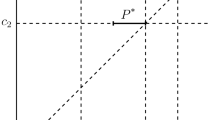Abstract
This paper develops a Coase-like solution of the problem of inducing Pareto optimal behavior in the presence of reciprocal externalities. In place of Coasean direct compensation between the parties to an externality problem, actors strategically match each other's externality-producing activity, and thus induce counterparts to internalize the external benefits or costs of their actions. The analysis suggests a general framework for analyzing social interactions in the presence of reciprocal externalities. As an application of the theory, a solution of the duopoly problem is noted.
Similar content being viewed by others
References
Aivazian VA, Callen JL (1981) The Coase theorem and the empty core. J Law Econ 24:275–281
Aivazian VA, Callen JL, Lipnowski I (1987) The Coase theorem and coalitional stability. Economica 54:517–520
Buchanan JM, Stubblebine WC (1962) Externality. Economica 29:371–384
Crawford VP (1985) Dynamic games and dynamic contract theory. J Conflict Resolution 29:195–224
Danziger L, Schnytzer A (1991) Implementing the Lindahl voluntary-exchange mechanism. Eur J Polit Econ
Doyle C (1988) Different selling strategies in Bertrand oligopoly. Econ Lett 28:387–390
Groves T, Ledyard J (1977) Optimal allocation of public goods: a solution to the free-rider problem. Econometrica 45:783–809
Guttman JM (1978) Understanding collective action: matching behavior. Am Econ Assoc Papers Proc 68: 251–255
Guttman JM (1984) Matching behavior and collective action: theory and experiments. Bar-Ilan University Working paper #8406
Guttman JM (1986) Matching behavior and collective action: some experimental evidence. J Econ Behav Organ 7:171–198
Guttman JM (1987) A non-Cournot model of voluntary collective action. Economica 54:1–19
Guttman JM (1990) Rational actors, tit-for-tat types, and the evolution of cooperation. Unpublished, Bar-Ilan University
Guttman JM, Miller M (1983) Endogenous conjectural variations in oligopoly. J Econ Behav Organ 4:249–264
Guttman JM, Schnytzer A (1988) Strategic interactions and the Coase theorem. Unpublished, Bar-Ilan University
Kreps D, Milgrom P, Roberts J, Wilson R (1982) Rational cooperation in the finitely repeated Prisoner's Dilemma. J Econ Theory 27:245–252
McKelvey RD (1988) Evolutionary explanations of rationality paradoxes. Unpublished, California Institute of Technology
Rubinstein A (1982) Perfect equilibrium in a bargaining model. Econometrica 50:97–110
Sandler T, Sterbenz FP, Posnett J (1987) Free riding and uncertainty. Eur Econ Rev 31:1605–1617
Author information
Authors and Affiliations
Additional information
We are indebted to L. Danziger, D. Samet, participants in faculty seminars at Bar-Ilan and New York Universities and at the University of Maryland, and two anonymous referees for helpful comments and discussions. All remaining errors are our own.
Rights and permissions
About this article
Cite this article
Guttman, J.M., Schnytzer, A. A solution of the externality problem using strategic matching. Soc Choice Welfare 9, 73–88 (1992). https://doi.org/10.1007/BF00177674
Received:
Accepted:
Issue Date:
DOI: https://doi.org/10.1007/BF00177674




